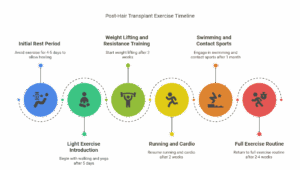Doctors recommend that their patients get plenty of rest after a hair loss treatment and avoid going back to their regular exercise routine for several weeks. However, while most people like to know the precise amount of time that they will be missing their training sessions, it all depends on the type of activity you like to engage in.
We will go over the general post-op timeline and explain why resting is so important in the initial stages of recovery and when it’s safe to resume different activities.
Why Exercise Timing Matters After a Hair Transplant
The main concern right after an operation, and the reason why you should avoid exercising, is that physical strain, sweat, and increased body and blood pressure can all negatively affect the recovery process.
The transplanted area will be swollen for a week after the procedure, and there can be some light bleeding, which means the risk of infection is higher. The follicles also need time to fully take root, so some forms of exercise will be possible sooner, while others must wait for the donor hair to heal and strengthen properly.
Why You Should Avoid Working Out Right After a Hair Transplant
Bending past the waistline, an elevated heart rate, and the moisture from sweating can all increase the risk of the newly transplanted hair getting dislodged or other complications occurring.
During the first 4–5 days post op, everything is still sensitive, and it takes some time for the swelling to subside and the light bleeding to stop, as the scabs slowly form. Even light contact and high-pressure showers are forbidden at this time, as the entire area is very delicate.
Timeline: When Can You Safely Exercise After a Hair Transplant?
After a typical FUE hair transplant, a patient can resume exercise after the first 14 days. This is the amount of time it takes for everything to heal and the scabs to fall out on their own. It’s at this point that you can also resume showering and using natural shampoos.
However, it’s still best to avoid hats and other headgear and any rough physical contact with the scalp, as well as direct sunlight, excessive sweating, and being submerged in water. You will be able to return to more intense activities in around one month after the surgery, and you shouldn’t rush the process if you want to get the best before and after results.
When Can I Resume Specific Types of Exercise?
As mentioned, you will need to refrain from some types of physical activity for a bit longer than others to give the transplanted hair follicles enough time to heal and grow stronger.
Here is a quick rundown of how soon after your hair transplant procedure you can return to certain activities:
- Walking and yoga – after the first five days, you can take up this type of light exercise for short sessions, taking care not to push yourself to the point where you start to sweat.
- Weight lifting and resistance training – two weeks post surgery, you can hit the gym again or do bodyweight workouts at home or in the park. For the first few sessions, take longer rest periods between sets and stop one or two reps before hitting muscular failure. Slowly build back up to your regular intensity over a week or two.
- Running and cardio – you can also start running or doing any other intense cardio exercise that elevates the heart rate and causes you to sweat a lot after about two weeks.
- Swimming and contact sports (e.g., football, boxing) – for sports that require you to dive into the water or take hard physical contact to the head, you will need to wait a full month after the operation.
As long as you follow these guidelines and get plenty of rest, you can return to any sport or exercise routine within two to four weeks.

Risks of Exercising Too Soon After Hair Transplant Surgery
The main reason you shouldn’t exercise after a hair transplant is that it puts you at risk of dislodging hair grafts, which can lead to infections, excessive bleeding, slower healing, and suboptimal results. The grafts will have to heal up and become fully rooted in the recipient area before you can subject them to any kind of physical shock or moisture.
That’s why you need to avoid activities that get your heart pumping for the first week and just focus on getting as much rest as possible. After that, follow the timeline we’ve explained above to slowly get back to your regular training regime, but always be extra careful to avoid bumping into things or any hair pulling.
Relax and Take it Slow as Your Scalp Heals
It’s never a good idea to rush back into training after a hair transplant in Turkey, as it can have serious consequences on your transplanted hair. The first few weeks post-op should be nice and slow, even a bit boring, and you can take this time to kick back, relax, and watch a new TV show or do some reading.

